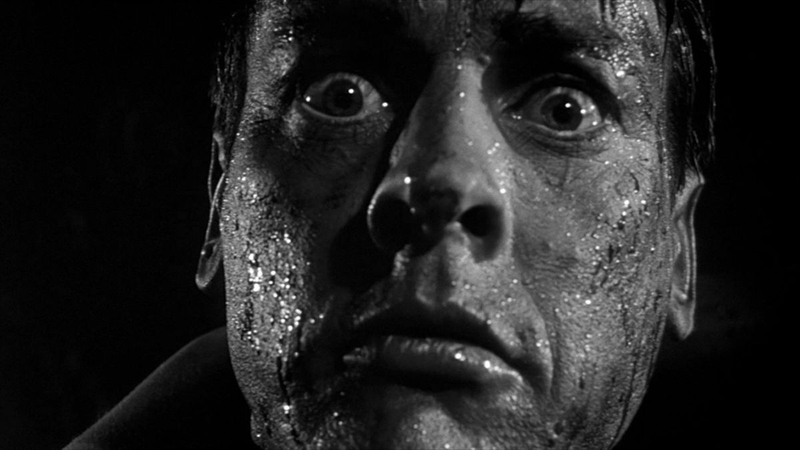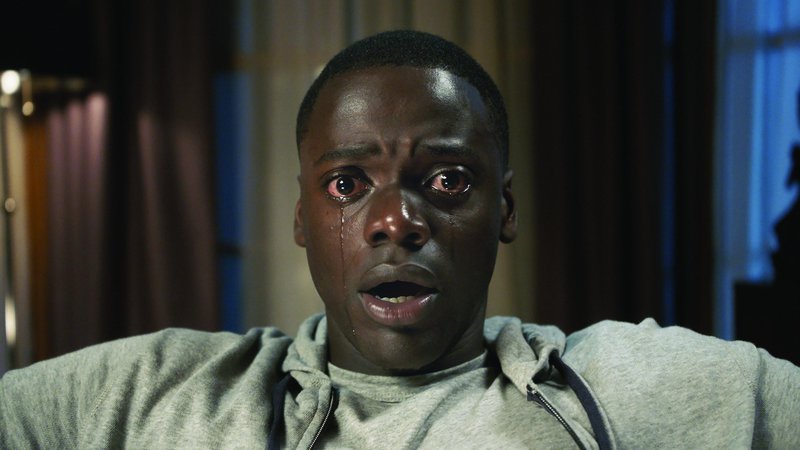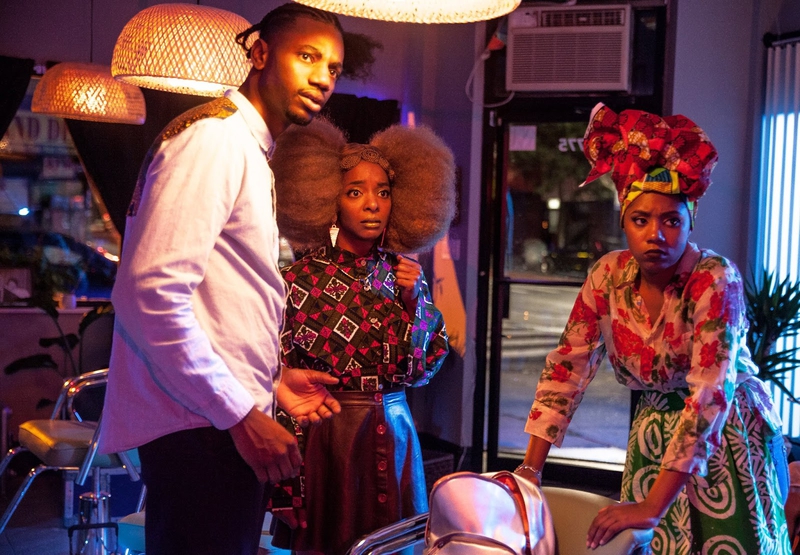Narratives of body snatching and possession take The Swallowing to the realm of the interior, which is to say, the body and psyche. From Invasion of the Body Snatchers to The Exorcist, The Skeleton Key, and Get Out, the terror these films inspire derives from an essential loss of personal agency and sovereignty—a consumption of the Self that occurs at the psychic level. Most often, this threat appears as demonic possession (The Conjuring, Jennifer’s Body) or as a type of alien imperialism (The Thing, The Faculty), but there also exists a long history of body snatching narratives preoccupied with anxieties around race, gender, religion, and medical technology.
In discussion of Invasion of the Body Snatchers (1956) and The Thing (1982), Dani Bethea addresses “the alien’s reluctance to inhabit a non-White body” and how the project of white supremacy aligns with the project of alien imperialism as they both seek an outcome of “White global…domination.” The alien seeks to establish dominion through the already-established power channel of structural whiteness. To this point, Bethea identifies how “The fear this elicits for the White audience is that once they have been taken over by the alien, they now will become ‘the other’, the unknown, and the menace.” Put another way, the fear this elicits is the same fear that undercuts modern replacement theory: the idea that a contaminating Otherness threatens white purity (and the superiority it begets). Once “snatched,” the sanctity of white Subjecthood and its associated mythologies of blood purity, inherent goodness, and adjacency to the divine is contaminated and essentially devoured.

And what of the modern body snatchers narratives that aren’t attached to alien invasions? I’ve written before about 1819’s The Black Vampyr, which features a body-snatching throughline in which the formerly enslaved vampire- after killing his cruel master- kidnaps the slaveowner’s small son, raises him in servitude, returns to the island several years later, and marries the former master’s widow. To the novel’s nineteenth-century white audience, horror is meant to arise from its reversal of white supremacist hierarchy—not necessarily the horror of enslavement itself, the most literal form of body-snatching ever to exist. Rather than address the actual source of the terror, the novel’s logic deflects, designed as it is to incite fear of what could happen to white slaveowners in the face of a vengeance-motivated insurrection. In other words, white horror arises from the fear that Black folks might do to them what they’ve done to us. In the end, so-called “order” is restored when all the vampire insurrectionists are murdered, Personne- the slaveowner- resurrected, and the white family unit reunited. But as Jeffrey Jerome Cohen notes, “the monster always escapes,” another way of saying “the monster always comes back.” In The Black Vampyr, this monster takes the form of a biracial Black child: the horror of which accounts for this warning tale’s conclusive note. Consistently we see Blackness equated with contaminate or infection, a narrative formula that develops into a couple tropes of twentieth-century cinema.
Though 1934’s Chloe, Love Is Calling You sets itself up as a standard tragic mulatto tale, its Big Twist reveals that the titular Chloe (Olive Borden)- who we believe to be a light-skinned/white-passing Black girl- is actually the white daughter of a local politician, kidnapped in infancy by Mandy (Georgette Harvey), her Black “mother,” as retribution for her husband’s lynching. Once again, the film resolves itself with the restoration of the white family unit and continues to reflect this particularly white anxiety of being duped or rendered psychically powerless by a Black person, primarily as a result of voodoo or “black magic.” Such projects work to manufacture and export fear of African spiritualities by rendering them “evil” or “satanic” in antagonistic opposition to so-called Christian “goodness”: a rendering of The Swallowing that occurs at the religious and spiritual level. But further, they also enact a type of raceplay designed to essentialize (white) purity logic with morality logic. To the film’s presumed white audience, horror is meant to arise from Chloe being stripped of her whiteness and forced to live as though she were Black, which, when conflated with prescriptive anti-Black moralities, translates to Chloe being stripped of her goodness and forced to live in sin. To be clear, this does not say anything actual or real about Black life or Black people–it is simply structural white ideology telling on itself.

These representations of hoodoo or voodoo (distinct from Vodoun, an actual religion) as a method of body snatching that renders it an iteration of The Swallowing appears again and again throughout the twentieth century in films like White Zombie (1932), Black Moon (1934), Ouanga (1936), Voodoo Woman (1957), Scream Blacula Scream (1973), Sugar Hill (1974), The Serpent and the Rainbow (1988), Voodoo Dawn (1991), Voodoo (1995), and into the twenty-first century with The Skeleton Key (2005) and Jessabelle (2014). If we understand the monster as a form of cultural technology, what ends does it serve to demonize African spiritualities, and where does this continue to appear in contemporary horror cinema? Further, how does it challenge white supremacy to recognize white desire (and hunger) for Black bodies and Black cultural production?

Spell
Spell continues the “voodoo horror” tradition demonstrated in Chloe, Love Is Calling You that fuses religious and spiritual anxiety with racial anxiety. However, the project is distinguished by its almost entirely Black cast, its intracommunal core conflicts, and Black director in Mark Tonderai. But don’t let the minstrelsy fool you—Spell is a story imagined and written by a white screenwriter, Kurt Wimmer, a fact evident in the film’s treatment of African spiritualities and its understanding of said intracommunal conflicts.
Taking much of its structural influence from The Texas Chainsaw Massacre, The Hills Have Eyes, and Misery, Spell stars Omari Hardwick as Marquis T. Woods, a successful businessman whose luxury lifestyle is a far cry from the rural Appalachian upbringing he fled from when he was young. Following news of his abusive and estranged father’s death, he piles his wife, son, and daughter into the family plane with the intention of returning home to pay their last respects—until a storm brings the plane down somewhere in the Appalachian mountains. When Marquis awakes, he finds himself wounded and taken hostage by Mrs. Eloise (Loretta Devine) and her family. Over a series of escapes and recaptures, we come to learn that Eloise is a rootworker and conjure woman; she and her family not the descendents of slaves, but have themselves been around since the mid-nineteenth century, their bodies sustained through “that old-time slave magic” which of course includes ritual human sacrifice and cannibalism.

Layered in its storytelling is a completely reductive commentary on intracommunal class dynamics that essentially adopts the “crabs in a barrel” mythology that Black folks don’t like to see each other succeed. It equates hoodoo with a type of primitivism that again taps into this trope of presenting African religions and spiritualities as The Swallowing, and ultimately serves to reproduce the anxieties of structural whiteness—which makes sense, given its white screenwriter. In slapping a Black director and Black actors on an otherwise obviously white story, the film itself enacts a type of minstrelsy that represents its own form of body snatching. To this end, Wimmer doesn’t strike me as much different than the Armitages of Jordan Peele’s Get Out: willing to don a Black skinsuit with no respect for Black personhood or tradition, if it means the opportunity to incur profit.

Get Out
By contrast, Get Out presents the white family unit/family home/nuclear family structure as The Swallowing: an entity that devours Black personhood in order to pick apart the bits of us deemed most desirable, valuable, or- as Vincent Woodard describes- most delectable. The Armitages and their partner-clientele fetishize Black physicality, creativity, and sensuality and therefore place value on the utility of the Black body distinct from the Black person who inhabits it. We see this constantly demonstrated throughout the film but most overtly in Jim Hudson (Stephen Root), the art dealer and failed photographer who buys Chris (Daniel Kaluuya) for his eyes, assuming that with his eyeballs’ material tissue comes his talent. He doesn’t see that vision or artistry as the result of Chris’ distinct perspective as a person.
To this point, Peele departs from conflicts of faith, spirituality, and religion to return to the anxieties around medical science and technology put forth in Frankenstein. These, he addresses alongside the literal body-snatching that had been ongoing for centuries before the novel’s writing. In presenting the Armitages as mad scientists- developers of the coagula procedure that allows a white person to steer the Black body they occupy- Peele points viewers to the history of medicine and rapid medical advancement in the eighteenth and nineteenth centuries, much of which was founded through the exploitation and brutalization of Black people. For instance, Marion J. Sims, the “founding father” of gynecology, conducted his torturous experimental procedures on enslaved Black women. This, too, is a type of body snatching.

In contrast to white-imagined representations of hoodoo and voodoo as The Swallowing, Peele presents white medicine and medical experimentation that bears no regard for the humanity of their subjects as such. The Sunken Place refers to this condition of material and mental confinement. It is the barracoon (the slave ship), the depths of the Atlantic, the pit, a grave—but it is also a stomach. When Woodard asks, “how…it feel(s) to be an edible, consumed object?...to be consumed on the levels of body, sex, psyche, and soul?” the answer is in the Sunken Place.

Hair Wolf
As I’ve written previously and in greater depth, Mariama Diallo’s 2018 short addresses body and soul snatching as it pertains to gentrification, cultural appropriation, and desirability politics. When Count Beckula (Madeline Weinstein) “goes viral” on Cami’s (Kara Young) friends, she infects them with the plague of internalized anti-Blackness. Once proud and firmly rooted in their Blackness, Janice (Trae Harris) trades in her full, gorgeous curls for straightened blonde strands; Damon (Jermaine Crawford) unceremoniously dumps his devoted girlfriend, Eve (Taliah Webster) for Beckula while professing that “all lives matter.” Meanwhile, trend-hungry white zombies splay themselves on the salon’s doors and windows, groaning “braaaaaaids.” When the virus begins to take hold of Eve- which is to say, as she descends into despair at Damon’s rejection- Cami must help her fight it by reminding her of Black women’s beauty and power.

Like Get Out, we see Black personhood devoured, and our bodies and style picked apart for the pieces deemed most delectable by whiteness. Peele makes this subtext overt when, prior to the auction, one of the Armitage’s guests proclaims that “Black is in fashion.” In Hair Wolf, culture vulturism appears as the occasion of The Swallowing, “snatching souls” through the simultaneous appropriation of Black cultural production and devaluation of actual Black people.






